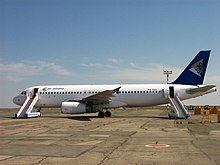|
Transport in Kazakhstan
The vast territory of Kazakhstan spans across 2,700,000 km2 (1,000,000 sq mi). The population density is low in Kazakhstan, and the centers of industry and agriculture are spread out and remote from world markets. RailwaysRailways provide 68% of all cargo and passenger traffic to over 57% of the country. There are 15,333 km (9,527 mi) in common carrier service, excluding industrial lines.[1] All railway lines in Kazakhstan are built in 1,520 mm (4 ft 11+27⁄32 in) gauge, of which 4,000 km (2,500 mi) is electrified (2012).[1] Kazakhstan Temir Zholy (KTZ) is the national railway company. KTZ cooperates with French loco manufacturer Alstom in developing Kazakhstan's railway infrastructure. Alstom has more than 600 staff and two joint ventures with KTZ and its subsidiary in Kazakhstan.[2] In July 2017, Alstom opened its first locomotive repairing center in Kazakhstan. It is the only repairing center in Central Asia and the Caucasus.[3] As the Kazakhstani rail system was designed during the Soviet era, rail routes were designed ignoring inter-Soviet borders, based on the needs of Soviet planning. This has caused anomalies, such as the route from Oral to Aktobe passing briefly through Russian territory. It also means that routes might not suit modern-day Kazakhstani needs.[4][citation needed] Kazakhstan's developed railway system promotes international and regional trade connecting Asia and Europe. In 2019, the transit of goods through Kazakhstan increased 23% to 664,000 containers.[5] Railway links with adjacent countries
The strategy of transport development in Kazakhstan until 2015 is to build 1,600 km (990 mi) of new electrified and 2,700 km (1,700 mi) of existing railway stations.[citation needed] In 2006, a standard gauge rail link from China to Europe was proposed.[6] In 2007, it was proposed to eliminate break of gauge at Druzhba-Alashankou by converting the Kazakhstan main line to European gauge.[citation needed] In 2008, BOOT line from Zhetigen to Khorgos on the China border.[7] The line would branch off the existing railway near Shaquanzi.[8] MapsTowns served by railRapid transit and tram systems Almaty There is a small (8.56 km (5.32 mi)) metro system in Almaty, the former capital and the largest city in the country. Second and third metro lines are planned in the future. The second line would intersect with the first line at Alatau and Zhibek Zholy stations.[9] In May 2011, the construction of the second phase of the Almaty Metro line 1 began. The general contractor is Almatymetrokurylys. The extension includes five new stations, and will connect the downtown area of Almaty with Kalkaman in the suburbs. Its length will be 8.62 km (5.36 mi).[10] The construction is divided into three phases. The first phase, the addition of the two stations Sairan and Moscow with a length of 2.7 km (1.7 mi)[10] opened in 2015. There was a tram system of 10 lines which operated from 1937 to 2015.[11] AstanaA metro system is currently under construction in Astana , the capital city. The metro line had been a long time coming and the project was abandoned at one point in 2013,[12] but an agreement was signed on 7 May 2015 for the project to go ahead.[13] OskemenIn Oskemen, a tram system was operated until 2018.[14] Opened between 1959 and 1978, the tram was a popular form of transport in Oskemen/Ust-Kamenogorsk. At its peak, it had six routes, but in the end it had four routes in operation. It had a fleet of 50 working tram cars.[15] Pavlodar In Pavlodar, there is a 86 km (53 mi) tram network which began service in 1965. As of 2012[update], the network has 20 regular and three special routes. The network has a 60% share of the local public transport market. Its fleet of 115 trams are due to be replaced and in 2012, with the city announcing plans to purchase 100 new trams.[16] Temirtau There are two tram lines in Temirtau.[17] Highways
 Kazakhstan has a road network stretching over 96,000 km (60,000 mi), most of which is in need of modernization and repair. It is, however, notable for containing the easterly terminus of European route E40, which contains the most easterly section of the Euroroute network.
It is stated in the CIA Factbook that Kazakhstan has a total road network of 93,612 km (58,168 mi) which is made up of 84,100 km (52,300 mi) paved and 9,512 km (5,910 mi) unpaved roads (2008).[1] As of 2017[update], there were 3,845,301 registered cars and a total of 4,425,770 units of autotransport.[19][20] Five international routes pass through Kazakhstan, totaling 23,000 km (14,000 mi). These highways are:
In 2009, the country began the construction of the "Western Europe - Western China" highway, which will be completed by 2013[clarification needed]. The total length of the road will be 8,445 km (5,247 mi), of which 2,787 km (1,732 mi) will be in Kazakhstan (Aktobe, Kyzylorda, South Kazakhstan, Zhambyl and Almaty oblasts). The thickness of the asphalt and concrete pavement will be 80 cm (31 in), and the expected lifespan of the highway will be 25 years, without a major overhaul, and the maximum speed limit 120 km/h (75 mph). The project includes a number of bridges over rivers, road maintenance facilities, bus stop areas, avtopavilony, cattle trails, and electronic signage. Simultaneously with the construction of this highway, roads will be repaired and built in areas along its route.[21][22][23] MotorwaysThe motorway network in Kazakhstan is rather underdeveloped, mainly due to the low population density in the country, which doesn't require wider roads on long distances. There is a total of 490 km of motorways. The following are the only existing multi-lane, double carriage roads in Kazakhstan:
PipelinesAs of 2010, pipelines in Kazakhstan consist of:[1]
Waterways and waterborne transportationThere are 4,000 km (2,500 mi) of waterways on the Syrdariya (Syr Darya), 80%, and Ertis (Irtysh) rivers, (2010)[1] Ports and harboursCaspian SeaOn riversMerchant MarineThe merchant marine has a total of 119 vessels as of 2017[update] consisting of four general cargo vessels, ten petroleum tankers, and 105 other vessels.[24] AirportsKazakhstan has a total of 97 airports. (2012)[1] However, it is quoted as having a total of 449 airports in 2001.[18] The large area of the country and the associated long distances makes air travel a very important component in domestic travel. Airports - with paved runwaystotal: 64[1]
Airports - with unpaved runwaystotal: 33[1]
Open Sky regime11 airports of Kazakhstan are part of the open sky regime, which allows more foreign carriers and more flights to operate at Kazakh airports. They include the airports of Astana, Almaty, Shymkent, Aktau, Karaganda, Ust-Kamenogorsk, Pavlodar, Kokshetau, Taraz, Petropavlovsk, and Semey.[25] HeliportsTotal: 3 (2012)[1] Airlines The European Commission blacklisted all Kazakh carriers in 2009, with the sole exception of Air Astana. Since then, Kazakhstan had consistently been taking measures to modernize and revamp its air safety oversight. Thus, in 2016, the European Aviation Safety Agency removed all Kazakh airlines from its blacklist citing “sufficient evidence of compliance” with international standards by Kazakh airlines and its Civil Aviation Committee.[26] In December 2021, it was announced that Kazakhstan’s aviation safety record increased to 84%, which is 15% higher than the global average. These statistics were reported from an audit conducted by the ICAO Coordinated Validation Mission.[27]
The New Silk RoadKazakhstan is actively involved in the New Silk Road initiative, which is an infrastructure project expected to significantly accelerate and reduce the cost of goods delivery from China to Europe through Central Asia.[30] External linksWikimedia Commons has media related to Transport in Kazakhstan.
References
|
